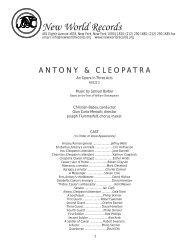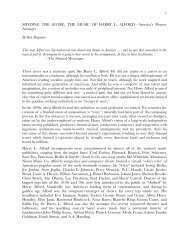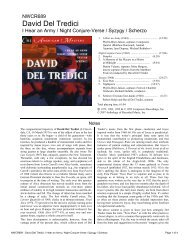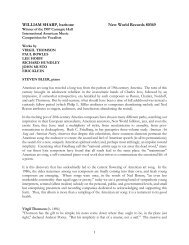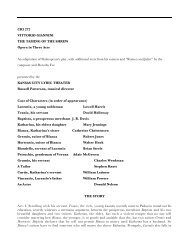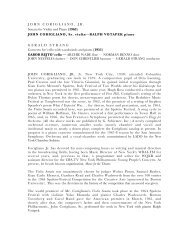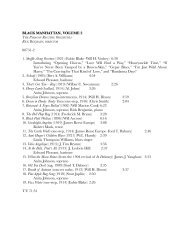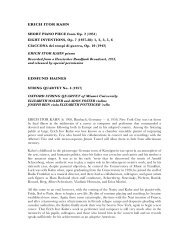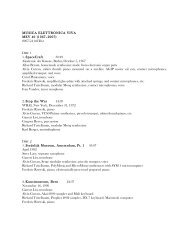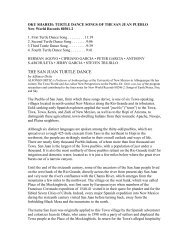PIANO MUSIC OF DAVID GUION - New World Records
PIANO MUSIC OF DAVID GUION - New World Records
PIANO MUSIC OF DAVID GUION - New World Records
Create successful ePaper yourself
Turn your PDF publications into a flip-book with our unique Google optimized e-Paper software.
<strong>PIANO</strong> <strong>MUSIC</strong> <strong>OF</strong> <strong>DAVID</strong> <strong>GUION</strong><br />
THE ARKANSAS TRAVELER — trans.<br />
MINUET<br />
SHEEP AND GOAT WALKIN' TO THE PASTURE — trans.<br />
THE LONESOME WHISTLER<br />
THE HARMONICA PLAYER<br />
THE SCISSORS GRINDER<br />
VALSE ARABESQUE<br />
MOTHER GOOSE SUITE<br />
Steve Buchanan, pianist<br />
Leopold Godowsky, pianist, eminent musical pedagogue and European sophisticate, was amused. It was<br />
1911, and a young man fresh from the prairies of West Texas had arrived at his doorstep at the Vienna<br />
Royal Conservatory virtually unannounced. <strong>DAVID</strong> <strong>GUION</strong>, age nineteen, had come to take lessons,<br />
but fearing rejection, had neglected to write in advance for an appointment. Godowsky surveyed with<br />
curiosity Guion's tan, buttoned shoes and his western hat, elicited from him the information that he was<br />
the son of a lawyer and rancher, then asked him to play the piano. The young American did — “very<br />
badly. I was frightened out of my wits,” Guion recalls in his memoirs. And what made Guion think<br />
Godowsky would take him as a student, the great pianist wanted to know. “My father told me any<br />
teacher would accept me if I paid enough for my lessons,” Guion replied. Godowsky laughed<br />
uproariously. “So I am to be bought, like your father buys a fine bull.” And the amused virtuoso<br />
assigned young David to an assistant, to prepare him for lessons with Godowsky himself.<br />
Thus began three of the most pleasurable and instructive years in the long life of David Guion, pianist,<br />
rodeo cowboy and composer whom Olin Downes of The <strong>New</strong> York Times once compared to Stephen<br />
Foster as a writer of the music of America.<br />
Cosmopolitan Vienna was certainly a far cry from Guion's home territory. What Viennese character, for<br />
instance, could possibly compare with Judge Roy Bean, “the law West of the Pecos,” who dispensed his<br />
hard liquor and frontier justice at the border village of Langtry about 160 miles from Guion's home<br />
town of Ballinger. Guion met the judge in 1898, and in later years his memory of the occasion<br />
consisted mainly of Bean's white hair and long white beard and the bag of stick candy the “judge,”<br />
really a justice of the peace, gave to him. And he remembered the hanging tree in front of the saloon.<br />
Guion was born in 1892 in Ballinger, which, if it had no inhabitants quite as colorful as Roy Bean, had<br />
more than its share of real-life cowboys and other workers and artisans necessary to the cattle business.<br />
Ballinger was surrounded by ranches, including the T-O-Bar-G, the Guion family spread. Almost from<br />
the time he could walk young David was at home on a horse, and he took an active part in the work<br />
and play of the ranching community.<br />
From the beginning Guion also had music in his bones. As a baby he heard his mother — a talented<br />
amateur pianist and soprano — sing the nursery rhymes, cowboy songs and frontier ballads popular in<br />
the Old West. From his Mammy Neppie, a former slave who was his childhood nurse, he heard Negro<br />
spirituals and other melodies reflecting the Black experience. Fiddling and guitar playing were an<br />
important recreation at family and community gatherings. All this music was indelibly impressed on the<br />
young boy's mind; years later it inspired numerous transcriptions and original pieces.
Guion's first piano teacher was his mother. Later he was taught by Charles J. Finger, a mysterious<br />
Englishman who had moved from London to San Angelo, Texas. “When anybody came to Texas in<br />
those days, they were never asked questions about their past,” Guion says. On Saturdays David's<br />
parents put him on a train in Ballinger for the thirty mile ride to his lessons in San Angelo. A placard<br />
around his neck informed the conductor as to his name and destination. On Sundays Finger placed his<br />
young pupil on the train for the ride back home. Eventually the boy received musical training at<br />
educational institutions in Jacksonville, Illinois and Fort Worth, Texas.<br />
It remained only for the Austrian experience to add the final element to Guion's musical personality.<br />
Vienna, in the era immediately prior to <strong>World</strong> War One, was the center of European cultural life, if not<br />
of the world. It was still very much the city of Brahms and Strauss and Mahler. Old Franz Josef still<br />
reigned. Resident or prominent in the musical life were such figures as Emil Sauer, Ferruccio Busoni,<br />
Ignace Jan Paderewski and Vladimir de Pachmann — all of whom Guion met through his teacher,<br />
Godowsky. Young Arthur Rubinstein was there, as were Schoenberg and Berg and Richard Strauss.<br />
Guion spent three years in this fascinating milieu and came to love the music as well as the scenic<br />
beauties of Austria. He might have spent the rest of his life as an expatriate if <strong>World</strong> War One hadn't<br />
intervened and forced him to sail for home.<br />
After a brief period of teaching in Texas, Guion headed for <strong>New</strong> York. He first came to public attention<br />
when Nora Bayes sang his Old Maid Blues in the George M. Cohan revue of 1918. M. Witmark and<br />
Sons and G. Schirmer began publishing his music which quickly became popular and was sung by such<br />
outstanding performers as Mmes. Schumann-Heink, Galli-Curci, and Mabel Garrison. In 1924 he<br />
interested the manager of <strong>New</strong> York's Roxy Theatre in a musical production with a cowboy theme.<br />
When Guion's show, Prairie Echoes, opened, it included a number of pieces that were to make his name<br />
famous throughout the country: his transcriptions of Turkey in the Straw and The Arkansas Traveler, his own<br />
piece called The Harmonica Player, and several of his songs of which Home on the Range was to become the<br />
most popular.<br />
Guion's newfound success did not draw him completely away from his beloved West. In the '20s he<br />
toured the summer rodeo circuit as a competitor. One of his proudest accomplishments came in 1923<br />
when he won the bronc-riding championship at the Frontier Days Rodeo in Cheyenne, Wyoming,<br />
riding a horse called “Hell Raisin' Molly.” It was one of many Guion rodeo prizes.<br />
The '20s, '30s and '40s were Guion's heyday. He toured widely as a composer and performer. His music<br />
was sung and played by artists as varied as Percy Grainger, Bing Crosby, John Charles Thomas and the<br />
<strong>New</strong> York Philharmonic under Arturo Toscanini: John Philip Sousa made his own band arrangement<br />
of Guion's Turkey in the Straw. Guion also wrote large-scale orchestral compositions.<br />
In the 1960's “rock 'n' roll put a crimp in my tail,” as Guion puts it. But if Guion's music was no longer<br />
prominently presented by the mass media, it was indelibly a part of the American musical heritage, and<br />
still capable of giving great pleasure.<br />
The music on this record is typical Guion. It includes several of the most popular pieces of his career,<br />
and much of it illustrates an important aspect of his style: his use of naive and folkish material, but<br />
transformed by his sophisticated imagination and musical technique into something far from naive.<br />
THE ARKANSAS TRAVELER is a popular old folk tune that Guion first heard as a fiddle<br />
“breakdown” played by a former slave named Elijah Cox (Ol' Coxy), widely known as one of the best<br />
bronc-busters and fiddlers in West Texas. Guion's piano arrangement of 1929, by no means child's play,<br />
was often programmed by Percy Grainger.<br />
MINUET, an original composition of 1923, is an elegant, stately piece which reflects late 19th century<br />
musical tastes that remained popular through the early decades of the 20th century. The piece is clearly<br />
a product of Guion's years of study with Godowsky. Even though Guion considers himself largely self-
taught in composition, the influence of the European masters whose works he admired and played is<br />
evident in his keyboard writing.<br />
SHEEP AND GOAT WALKIN' TO THE PASTURE is another fiddle transcription made famous by<br />
Guion. The arrangement, dating from 1922, uses bits and pieces of other old cowboy breakdowns and<br />
some original ideas — “sidekicks,” he calls them — of Guion's own.<br />
THE LONESOME WHISTLER, an original composition from a suite titled Alley Tunes, Three Scenes<br />
from the South (1926), is a lyrical pianistic description of a boy ambling down an alley late at night.<br />
THE HARMONICA PLAYER is a lively, contrasting piece from the same suite. It has long been one of<br />
Guion's most popular compositions.<br />
The itinerant scissors grinder, with his sharpening stone, was a familiar figure in the West Texas of<br />
Guion's childhood. Yet if Guion's composition, THE SCISSORS GRINDER (1930), was inspired by<br />
memories of frontier America, that is rot reflected in the music, which is clearly influenced by 20th<br />
century European music, French impressionism in particular.<br />
The brilliant VALSE ARABESQUE (1927) is another original piece with European, rather than<br />
American, antecedents. It is in a grand waltz style popular in the virtuoso programs of the late 19th and<br />
early 20th centuries. One could imagine Godowsky, himself, playing it.<br />
The MOTHER GOOSE SUITE (1937) offers some of Guion's most charming music. The suite<br />
consists of 17 short, descriptive movements, rather Schumann-like in concept, of which the first and the<br />
last are the most ambitious pianistically. The first, HEY, DIDDLE, DIDDLE, uses an original Guion<br />
tune; the rest are based on nursery tunes of J.W. Elliott. While the subject matter of the suite is naive,<br />
Guion's treatment of it is sophisticated, replete with characteristic flashes of Guion humor such as the<br />
musical scampering of mice or the barking of dogs in No. 6, THE THREE LITTLE MICE. The most<br />
familiar nursery tunes are used by Guion as well as some less familiar ones such as THE MAN IN THE<br />
MOON (No. 9), CURLY LOCKS (No. 15) and SIX LITTLE SNAILS (No. 16), with the snails'<br />
crawling represented by a painfully slow tempo. In spite of the subject matter, the pieces are not<br />
intended to be played by children, other than the most gifted; in the score the composer notes that<br />
many of the pieces require “the technical skill and artistic finish of the concert pianist.”<br />
The humorous aspects of the suite are quite apparent to the listener, but even more so to one who is<br />
also watching the score. Numerous performance directions are in English and detail such-advice to the<br />
pianist as that given for the elegiac, nocturne-like No. 4, THE NORTH WIND DOTH BLOW: to be<br />
played “slowly and with deep sympathy for Robin.” No. 11, DING, DONG, BELL, directs the<br />
performer frequently throughout to play “bashfully,” “with great sternness,” “reluctantly,” “sobbingly,”<br />
“churchy” and so forth.<br />
Stylistically, the pieces use a variety of compositional techniques ranging from traditional four-part<br />
harmony to the playful bitonality of the irresistible PUSSY CAT, PUSSY CAT, in which the treble is in<br />
E-flat while the bass is in E. In No. 13, HICKORY, DICKORY, DOCK. a series of minor seconds<br />
uncannily evokes the sounds of a cuckoo clock. No. 14, SING A SONG <strong>OF</strong> SIXPENCE, shifts<br />
unceremoniously and with infectious gaiety from E-flat major to D-flat major, back to E-flat, then to a<br />
surprise ending in E major making effective use of fourths, major sixths and sevenths. A dominant<br />
seventh ending chord of the interminably slow No. 16, SIX LITTLE SNAILS, leads to the exultant,<br />
fast-paced finale of No. 17, TOM, TOM, THE PIPER'S SON, the triumphant arpeggiated octaves<br />
and a long right-hand glissando ending the work with a crashing triple forte G major chord.<br />
10/6/80<br />
Olin Chism<br />
Music Editor The Dallas Times Herald
STEVE BUCHANAN is a graduate of the Oberlin Conservatory of Music, where he was a winner of<br />
the 1971 Oberlin Concerto Auditions, and holds graduate degrees from the University of Texas at<br />
Austin. He has given lectures, recitals and workshops in several states and his performances have been<br />
heard on radio broadcasts throughout the United States. Buchanan is on the faculty of James Madison<br />
University, where he also pursues his avocation as instrument builder. Among his creations is a replica of<br />
a 1784 Viennese fortepiano by J.A. Stein which he uses for recitals of the classical piano repertoire.<br />
This record was made possible by the David W. Guion Educational & Religious Trust.<br />
(original liner notes from CRI LP jacket)



